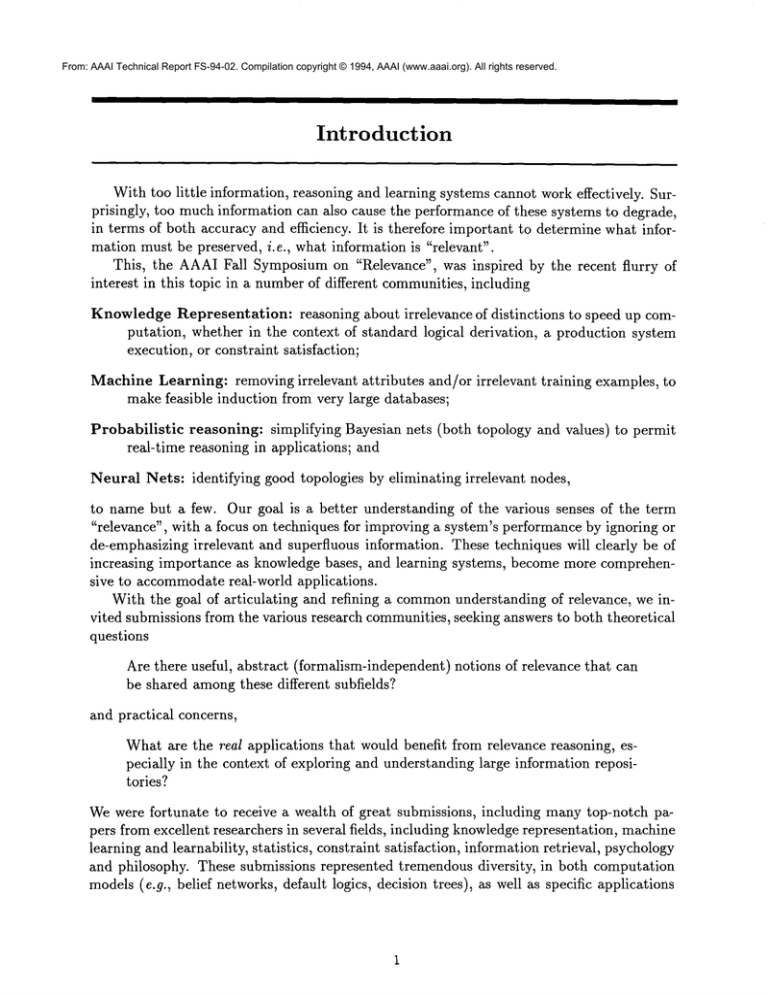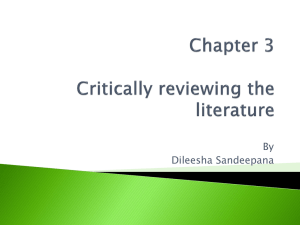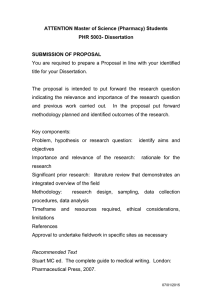
From: AAAI Technical Report FS-94-02. Compilation copyright © 1994, AAAI (www.aaai.org). All rights reserved.
Introduction
With too little information, reasoning and learning systems cannot workeffectively. Surprisingly, too muchinformation can also cause the performance of these systems to degrade,
in terms of both accuracy and efficiency. It is therefore important to determine what information must be preserved, i.e., what information is "relevant".
This, the AAAIFall Symposiumon "Relevance", was inspired by the recent flurry of
interest in this topic in a numberof different communities, including
KnowledgeRepresentation: reasoning about irrelevance of distinctions to speed up computation, whether in the context of standard logical derivation, a production system
execution, or constraint satisfaction;
Machine Learning: removing irrelevant attributes and/or irrelevant
makefeasible induction from very large databases;
training examples, to
Probabilistic reasoning: simplifying Bayesian nets (both topology and values) to permit
real-time reasoning in applications; and
Neural Nets: identifying good topologies by eliminating irrelevant
nodes,
to name but a few. Our goal is a better understanding of the various senses of the term
"relevance", with a focus on techniques for improving a system’s performance by ignoring or
de-emphasizing irrelevant and superfluous information. These techniques will clearly be of
increasing importance as knowledge bases, and learning systems, become more comprehensive to accommodatereal-world applications.
With the goal of articulating and refining a commonunderstanding of relevance, we invited submissions from the various research communities, seeking answers to both theoretical
questions
Are there useful, abstract (formalism-independent) notions of relevance that can
be shared amongthese different subfields?
and practical concerns,
Whatare the real applications that would benefit from relevance reasoning, especially in the context of exploring and understanding large information repositories?
Wewere fortunate to receive a wealth of great submissions, including manytop-notch papers from excellent researchers in several fields, including knowledgerepresentation, machine
learning and learnability, statistics, constraint satisfaction, information retrieval, psychology
and philosophy. These submissions represented tremendous diversity, in both computation
models(e.g., belief networks, default logics, decision trees), as well as specific applications
(e.g., text retrieval, gameplaying, real-time object recognition, plan recognition, speech processing, software agents, data mining). We accepted a diverse blend of papers -- ranging
from normative descriptions and theoretical analyses, to strong empirical studies, and even
some psychological investigations.
(In fact, a handful of the papers presented both intriguing theoretical insights as well as compelling empirical results on non-trivial application
domains!)
Wealso arranged a panel, peopled with major researchers from several different fields, to
help set the research agenda for relevance for the next five years.
Synopsis: In general, "relevance reasoning" is an (often implicit) component of an overall
system that is performing a "performance task", such as answering questions or learning a
function. Without loss of generality, we can view this system as one that receives inputs
(percepts) from the world, has some internal state (which could include encoded knowledge
about the world and its goals), and which affects the world through its actions (these can
recommendations for action (asking a human to push a button), or concrete actions (pushing
a button)). 1 By specifying the system only by this input-state-output
description, we are
deliberately hiding the details of the system’s inner working (for instance, whether it reasons
explicitly with propositions, or not).
Using this model, we can perform:
@
relevance
analysis
of the percepts.
To what aspects of the environment does
the system pay attention? Are these the appropriate aspects, for the system’s task?
For instance, which training examples (or alternatively,
which parts of each training
instance) does a learning agent use, or in the context of using a set of sub-agents
to answer queries, which parts of each given query does each sub-agent attempt to
answer? Such an analysis allows us to define the perception policy used by the agent,
and characterize its behaviour as a function of the environment and its task.
@
relevance analysis of internal state. An agent’s internal state often corresponds to
its model of the world (encoded perhaps as a propositional rule-base, Bayesian net, or
neural net), possibly augmented with aspects of the agent’s perceptual history. We can
then ask what aspects of its perceptual history should the agent remember? Are these
the right choices for its environment and task? For instance, an agent traversing the
World-Wide-Web looking for documents in a specific area may benefit by remembering
landmark locations (Mosaic home pages) to aid in navigation, much as a physical robot
benefits from remembering physical landmarks (the McGrawtower at Cornell).
relevance analysis of actions. Which actions or aspects of actions are superfluous for
a given task/environment pair? Can the system be directed to take more appropriate
actions? For example, a classification
agent that distinguishes among100 different road
conditions for the NAVLAB
system (and emits a label from 1-100) could potentially
be simplified into a system that produces one of only two labels (perhaps "slippery"
and "dry"), if the underlying effector system has only two control programs for driving
under these two conditions.
1 Cf., Stuart Russell and Peter Norvig,Artificial Intelligence: A Modern
Approach,Englewood
Cliffs, NJ:
Prentice Hall, 1995.
Two of the many obvious measures for assessing how well a system’s relevance policies work
are: (1) accuracy, or how appropriate are the responses generated by the system, and (2)
ficiency, for example, how well does the system employ its resources in delivering responses
of a given accuracy. Of course, we can consider various combination of these objectives,
which correspond to particular
trade-offs;
and in general, when considering systems that
reason under resource bounds (e.g., time deadlines),
these two performance measures are
quite interdependent.
We can also distinguish
between agents that autonomously derive appropriate policies
for monitoring relevant aspects of the environment, versus agents that use fixed policies,
hard-wired in by their designers for the agent’s specific task and environment. This issue is
especially prominent when considering the complexity of making relevance decisions online.
We invite readers to characterize the notion of "relevance" used in the included papers
along these various dimensions: identifying whether the system’s input, state, and/or output
is affected, (i.e., what specific policies are used to isolate the relevant percepts, internal state
and/or actions), the purpose motivating these relevance-based modification (accuracy versus
efficiency) and whether the system is using a fixed relevance policy versus a dynamic relevance
2policy.
Discussants
and Area Summarizers: The range of submissions show that people from
many, very different fields are interested in using something they call "relevance". One of
the symposium’s goals is to identify what (if anything) these uses have in common, with
an eye towards mutually-beneficial
exchanges -- of everything from useful formalisms and
frameworks, to perhaps implementations. A major obstacle to such interactions,
of course, is
that people from different disciplines use different terms for the same idea, work on different
problems, apply different methodologies, etc etc etc.
To interrelate
the various topics discussed, and thereby make the symposium more coherent, we found first-rate
researchers to provide the "framework" for each of the presented
papers, and help tie this paper in with other pertinent ideas -- especially those presented
in the symposium. Each of these "discussants" was asked to place the discussed paper in a
larger context, by familiarizing the audience with related work (including his/her own) and
by connecting the discussed work with the other computational paradigms represented at
the symposium, addressing questions like
- Whydo people in this research area (Knowledge Representation, Learnability, Statistics, ... ) care about this problem?
- Why should people care about this answer7
- Whoelse has used this idea?
- Who else should have used this idea?
- Howis this related to other ideas within other fields?
- What are the major limitations of the work presented -- e.g., are extensions needed
before it can be used effectively?
We also enlisted four exceptional speakers to provide summaries of each of the major
areas represented: Avrim Blum (Learnability),
Judea Pearl (Uncertainty Management),
2There are, of course, other secondary dimensions as well, for example, whether the relevance criteria
used to prune or order some aspect, etc.
are
Langley (Machine Learning), and Devika Subramanian (Knowledge Representation).
wasasked to first discuss a particular paper, and then to provide a survey of their respective
areas that was more comprehensive than the other discussants.
Wewere overwhelmedwith the high quality of the resulting discussions and summaries;
and heartily recommendreading them!
Thanks: Manypeople have contributed generously to the organization and planning of this
symposium. Weowe a great debt to all membersof the program committee for working with
heavy reviewing burdens under rigid time constraints: Nick Littlestone, Judea Pearl, David
MacAllester and Bart Selman. Wewould especially like to thank Bart for helping makefinal
decisions about both individual papers as well as the overall schedule. Wethank each of
the discussants and summarizers for commentingon their discussee’s papers -- a difficult
task made even more challenging by the realization that they knewthe authors would know
the discussant’s (aka critic’s) identity! Finally, we wouldlike to thank the AAAI,especially
its Fall SymposiumCommittee, for organizing these symposia in general, and helping us
arrange our symposiumin particular.
Welook forward to stimulating presentations
you all in NewOrleans this November!
Russ Greiner, Princeton, NJ
Devika Subramanian, Ithaca, NY
29 August 1994
and discussions
at the Symposium. See





